 Last additions - KANAGAWA 神奈川県 Last additions - KANAGAWA 神奈川県 |
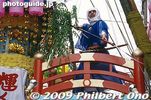
May 31, 2009
|
|

May 31, 2009
|
|

May 31, 2009
|
|

May 31, 2009
|
|

Tanabata originally had girls write their wishes for romance on strips of paper like these. They hung the paper on bamboo branches. Eventually, they used colored paper and the custom morphed into paper streamer decorations which we see today.May 31, 2009
|
|

May 31, 2009
|
|

May 31, 2009
|
|
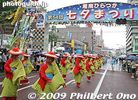
May 31, 2009
|
|

May 31, 2009
|
|

May 31, 2009
|
|

May 31, 2009
|
|

May 31, 2009
|
|

May 31, 2009
|
|

Snow White in TanabataMay 31, 2009
|
|

May 31, 2009
|
|

May 31, 2009
|
|

They also have a Tanabata dance parade along the main street led by the Shonan Hiratsuka Orihime weavers. 湘南ひらつか織り姫.May 31, 2009
|
|

Tanabata decoration made of plastic PET bottles.May 31, 2009
|
|

May 31, 2009
|
|

Very creative.May 31, 2009
|
|

May 31, 2009
|
|

This Tanabata decoration is made of plastic PET bottles.May 31, 2009
|
|

You are not allowed to pull on the streamers or tear off any parts.May 31, 2009
|
|

There are about 80 large Tanabata streamers on the main street called Shonan Star Mall.May 31, 2009
|
|

May 31, 2009
|
|

Ai-chan, table tennis playerMay 31, 2009
|
|

Shonan Hiratsuka Tanabata FestivalMay 31, 2009
|
|

Kitajima Kosuke, breastroke swimmer who won gold at Athens.May 31, 2009
|
|

SpringMay 31, 2009
|
|

Signboard explaining the concept of the four-season streamers.May 31, 2009
|
|

May 31, 2009
|
|

May 31, 2009
|
|

May 31, 2009
|
|

These four beautiful streamers represent the four seasons, from left to right, spring, summer, fall, and winter.May 31, 2009
|
|

Inside one of the streamers. See the origami cranes.May 31, 2009
|
|

May 31, 2009
|
|

Baseball coach Nagashima Shigeo and judoist Tamura RyokoMay 31, 2009
|
|

May 31, 2009
|
|

May 31, 2009
|
|

In Japanese, these decorations are called take-kazari (literally bamboo decorations) since they are supported by bamboo poles. 竹飾りMay 31, 2009
|
|

The 1st Hiratsuka Tanabata Matsuri was held in July 1951. Started by local merchants. Most Tanabata Matsuri in Japan are held in Aug. which is closer to the original July 7 date on the lunar calendar.May 31, 2009
|
|

Very intricate streamers at Shonan Hiratsuka Tanabata Matsuri in early July.May 31, 2009
|
|

In 1993, the festival was renamed from Hiratsuka Tanabata Matsuri to Shonan Hiratsuka Tanabata Matsuri. "Shonan" which is the beachside area in and around Kamakura.May 31, 2009
|
|

May 31, 2009
|
|

The Tanabata streamers are made by local businesses who may spend a few hundred thousand to a few million yen to make these decorations. They compete in a contest and the winners receive good publicity.May 31, 2009
|
|

May 31, 2009
|
|

July 7 is also during Japan's rainy season, so it is unusual to see Tanabata on July 7. As you can see here, it did rain a bit. The festival is now held by the city government.May 31, 2009
|
|

Japanese Olympians going to Athens in 2004.May 31, 2009
|
|

Until 2008, the festival used to be held on and around July 7, but now it is held for four days from the first Thursday of July. Depending on the year, July 7 might not fall within the festival period.May 31, 2009
|
|

Held for four days from the first Thursday of July, this is one of the largest Tanabata Festivals in the Kanto region. Usually called the Star Festival, about 3,000 colorful streamers hang all around the city center in the shopping district.May 31, 2009
|
|

Many Tanabata decorations feature current themes such as Japan's athletes going to the Olympics (in Athens in 2004 when this photo was taken).May 31, 2009
|
|

Tanabata decoration for Genji Monogatari (Tale of Genji).May 31, 2009
|
|

During the Shonan Hiratsuka Tanabata Festival, JR Hiratsuka Station on the Tokaido Line is festooned with Tanabata decorations.May 31, 2009
|
|

Outside JR Hiratsuka StationMay 31, 2009
|
|

JR Hiratsuka Station. Most of these pictures were taken in July 2004.May 31, 2009
|
|

Ladies in waiting. 奥女中May 31, 2009
|
|
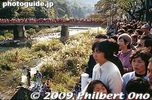
A large crowd watch the procession cross the Yumoto Ohashi Bridge. The parade ended at 2:30-3 pm.May 31, 2009
|
|

Hakone Daimyo Gyoretsu Procession poster. To get to Hakone Yumoto, take the Odakyu Line Romance Car from Shinjuku. A cheaper but longer way is to take the Odakyu Line to Odawara, then take the Hakone Tozan Railway train to Hakone Yumoto Station.May 31, 2009
|
|
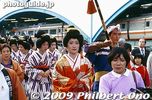
She was definitely the focal point of the procession before they started using a celebrity to play the daimyo. They past Yumoto Station in the background in the Hakone Daimyo Gyoretsu Procession.May 31, 2009
|
|
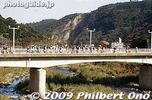
May 31, 2009
|
|

May 31, 2009
|
|
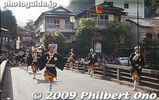
These men are the keyari who carry fluffy-topped poles and toss the poles to each other. 毛槍May 31, 2009
|
|

These men are the keyari who carry fluffy-topped poles and toss the poles to each other. 毛槍May 31, 2009
|
|
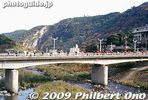
Crossing Yumoto Ohashi BridgeMay 31, 2009
|
|
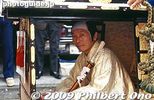
The daimyo feudal lord in Hakone Daimyo Gyoretsu Procession.May 31, 2009
|
|
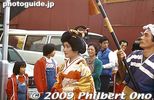
May 31, 2009
|
|
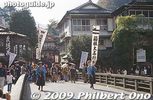
The start of the Daimyo Procession. You hear, "Shitaaaa-niii, shitaaaa-niiii" (Go down, go down!) by the tsuyu-harai dew sweepers who lead the way to tell people to clear the way and bow in respect. 下ニー 下ニーMay 31, 2009
|
|

May 31, 2009
|
|
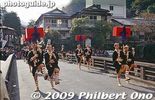
Luggage carriers carrying the hasami-bako boxes containing clothing and other necessities. 挟み箱May 31, 2009
|
|
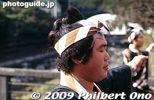
May 31, 2009
|
|

The Hakone Daimyo Gyoretsu Procession started in 1935 on the occasion of the Yumoto Expo. Except for the war years in the 1940s, this festival has been held annually.May 31, 2009
|
|
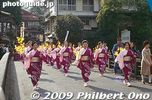
Before the feudal lord procession, there are normal people in dance groups, etc.May 31, 2009
|
|
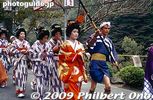
May 31, 2009
|
|

These men are the luggage carriers carrying the hasami-bako boxes containing clothing and other necessities. Hakone Daimyo Gyoretsu. 挟み箱May 31, 2009
|
|
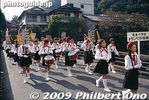
Yumoto Elementary SchoolMay 31, 2009
|
|
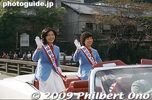
Hakone Tourism CompanionsMay 31, 2009
|
|
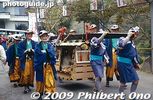
The daimyo lord is carried in a palanquin for the Hakone Daimyo Gyoretsu Procession. 大名駕籠May 31, 2009
|
|

May 31, 2009
|
|
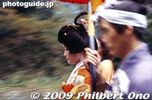
May 31, 2009
|
|
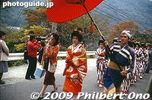
May 31, 2009
|
|

May 31, 2009
|
|
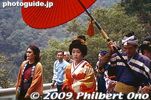
May 31, 2009
|
|
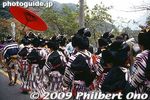
May 31, 2009
|
|
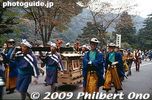
The procession reenacts the daimyo procession of Okubo Kaga, lord of Odawara on his way to Edo (Tokyo) for the periodic sankin kotai procession.May 31, 2009
|
|
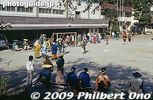
The following pictures were taken in an earlier year (not 2009). Hakone Daimyo Gyoretsu Procession starts at Yumoto Elementary School at 10 am. 湯本小学校May 31, 2009
|
|

Ladies in waiting. These pictures were taken some time ago (not in 2009). Since I saw it, the procession has gotten larger with more groups.May 31, 2009
|
|

Sep 30, 2008
|
|

Sep 30, 2008
|
|

Letter from Perry to his daughter.Sep 30, 2008
|
|

Second floor of Perry Memorial Hall has the main exhibits.Sep 30, 2008
|
|

Painting depicting Perry's landing at Kurihama to meet the local magistrate.Sep 30, 2008
|
|

Map showing where Perry's Back Ships went. One ship went as far as Haneda.Sep 30, 2008
|
|

Portrait of Commodore PerrySep 30, 2008
|
|

Bust of Commodore Perry at the entrance of Perry Memorial Hall Sep 30, 2008
|
|

First floor of Perry Memorial Hall has a portrait of Perry and a diorama. This small museum opened on May 1, 1987.Sep 30, 2008
|
|

Black Ship dioramaSep 30, 2008
|
|

Bust of Lord Toda at the entrance of Perry Memorial Hall Sep 30, 2008
|
|

The back of Perry Monument.Sep 30, 2008
|
|

Sep 30, 2008
|
|

Near the Perry Monument is the Perry Memorial Hall (Perry Ki'nenkan). Hours: 9:00 am - 4:30 pm, closed Mon. (open if a nationa holiday and closed Tue. instead). Phone 046-834-7531 ペリー記念館Sep 30, 2008
|
|

The back of the Perry Monument in Kurihama.Sep 30, 2008
|
|

Ship anchors flank the Perry MonumentSep 30, 2008
|
|

Plaque at the monument foot shows a map of Perry's voyage.Sep 30, 2008
|
|

The back of the Perry Monument in Kurihama.Sep 30, 2008
|
|

Perry Park faces the beach. It has the Perry Monument marking Perry's landing in Kurihama. ぺりー公園Sep 30, 2008
|
|

Sep 30, 2008
|
|

The monument words were written by Ito Hirobumi (Japan' first Prime Minister). It says, "Monument Commemorating the Landing of Navy Commodore Perry from the United States."Sep 30, 2008
|
|

Sep 30, 2008
|
|

"Monument in Commmemoration of the Landing of Commodore Perry, USN - Marquis Hirobumi Ito Grand Order of Chrysanthemum"Sep 30, 2008
|
|

The Perry Monument was originally built in 1901 by a US friendship association to mark the landing of Perry. ぺりー上陸記念碑Sep 30, 2008
|
|

Kurihama beach, where Commodore Perry first landed in Japan.Sep 30, 2008
|
|

Way to Perry Park.Sep 30, 2008
|
|

Restaurant named "Kurofune."Sep 30, 2008
|
|

Perry Road and way to Perry Park.Sep 30, 2008
|
|

Kurihama is easy to spot on the Miura Peninsula with these smoke stacks.Sep 30, 2008
|
|

Kurihama beach, where Commodore Perry landed on July 14, 1853.Sep 30, 2008
|
|

Sep 30, 2008
|
|

Car ferry arriving Kurihama Port from Kanaya, Chiba, across Tokyo Bay.Sep 30, 2008
|
|

Black ship on the sidewalk.Sep 30, 2008
|
|

Inside Kurofune Ichiba shopping arcade.Sep 30, 2008
|
|

Shopping arcade in front of Keikyu Kurihama Station. Walk down this road to go to the beach.Sep 30, 2008
|
|

Kurofune Ichiba shopping arcade. "Kurofune" means black ship, in reference to Commodore Perry's ships.Sep 30, 2008
|
|

Keikyu Kurihama Station is Kurihama's main train station with shopping arcades. The beach is also within walking distance. 京急久里浜駅Sep 30, 2008
|
|

Uraga and Kurihama are nationally famous as the place where Commodore Matthew Perry arrived in Japan in July 1853. This is on the Miura Peninsula at the mouth of Tokyo Bay.Sep 30, 2008
|
|

JR Kurihama Station is not far from the Keikyu Kurihama Station, but there's hardly anything near this station.Sep 30, 2008
|
|

Drawing of Perry by local junior high school students in Uraga. This is near Uraga Station. Uraga and Kurihama are a short train ride from Yokosuka Chuo Station.Sep 30, 2008
|
|

Sep 29, 2008
|
|

Sep 29, 2008
|
|

Sep 29, 2008
|
|

Sep 29, 2008
|
|

Sep 29, 2008
|
|

Local protestors put up signs opposing the deployment of the USS George Washington.Sep 29, 2008
|
|

Sep 29, 2008
|
|

In the day the USS George Washington arrived at Yokosuka, demonstrators were on hand to protest. They were kept far out of view of the big boat.Sep 29, 2008
|
|

Sep 29, 2008
|
|

Other lighthouse monumentsSep 29, 2008
|
|

View of Uraga Channel from Kannonzaki LighthouseSep 29, 2008
|
|

View of Uraga Channel from Kannonzaki LighthouseSep 29, 2008
|
|

The Kannonzaki Lighthouse is a short uphill climb from shore. The original lighthouse was Japan's first Western-style lighthouse built in the late 19th century by Verny. Destroyed by an earthquake in 1922, and again by the 1923 Kanto Earthquake.Sep 29, 2008
|
|

Lighthouse artifacts displayed outside. Foghorn on the far right.Sep 29, 2008
|
|

View of Uraga Channel from Kannonzaki LighthouseSep 29, 2008
|
|

Kannonzaki Lighthouse built in 1925. It stands 19 meters high, and 56 meters high from sea level. 観音灯台Sep 29, 2008
|
|

Spiral stairs inside the Kannonzaki Lighthouse.Sep 29, 2008
|
|

Sep 29, 2008
|
|

Light of the lighthouse.Sep 29, 2008
|
|

Tatara-hama BeachSep 29, 2008
|
|

Sep 29, 2008
|
|

More shipsSep 29, 2008
|
|

Shaped like a lighthouse.Sep 29, 2008
|
|

Kurihama in the distance.Sep 29, 2008
|
|

Map of Kannonzaki drawn by Commodore Perry when he first arrived in 1853.Sep 29, 2008
|
|

Sep 29, 2008
|
|

Sep 29, 2008
|
|

Sep 29, 2008
|
|

Types of ships that pass by.Sep 29, 2008
|
|

Sep 29, 2008
|
|

Kurihama in the distance.Sep 29, 2008
|
|

Walking path around Kannonzaki.Sep 29, 2008
|
|

Looks like the devil's washboard.Sep 29, 2008
|
|

CaveSep 29, 2008
|
|

Lookout point at Kannonzaki Park.Sep 29, 2008
|
|

This park is closed for some reason.Sep 29, 2008
|
|

Cape Kannonzaki is at the tip closest to Uraga Channel, the narrow mouth of Tokyo Bay. Ships must pass through here to enter or depart Tokyo Bay.Sep 29, 2008
|
|

Sep 29, 2008
|
|

Walking path around Kannonzaki Park.Sep 29, 2008
|
|

Container ships, oil tankers, passenger ships, navy ships, etc., all pass through here. Anybody have a picture of an aircraft carrier passing by here?Sep 29, 2008
|
|

If you like ship watching, come to Kannonzaki. This is the Nippon Maru cruise ship. にっぽん丸豪華クルーズ船Sep 29, 2008
|
|

Sep 29, 2008
|
|

Kannonzaki Park juts into Uraga Channel, the mouth of Tokyo Bay. It is a large park on a cape with walking paths and a lighthouse. 観音崎公園Sep 29, 2008
|
|

The shore is rocky.Sep 29, 2008
|
|

Lots of ships pass by here.Sep 29, 2008
|
|

Old porn theater in Yokosuka. Pretty amazing to see one these days, in the age of DVD/video rentals and Internet. It's almost a cultural icon.Sep 29, 2008
|
|

Kannonzaki ParkSep 29, 2008
|
|

Sep 29, 2008
|
|

Profanity is bad for the children...Sep 29, 2008
|
|

Sep 29, 2008
|
|

The famous Dobuita Street with military shops, bars, etc. "Dobu" means sewer, and "ita" is plank. They once had wooden planks covering a sewer gutter running down the street.Sep 29, 2008
|
|

Yokosuka jacketsSep 29, 2008
|
|

The street was likely more raunchy and infamous during the 1960s.Sep 29, 2008
|
|

Bust of Francois Verny, a French engineer who established the Yokosuka Arsenal. The park is named after him.Sep 29, 2008
|
|

Navy monument in Verny ParkSep 29, 2008
|
|

Navy monument in Verny ParkSep 29, 2008
|
|

Dobuita Street wasn't so impressive. Looks very well cleaned up though. I figure most people instead go to Yokohama for night life.Sep 29, 2008
|
|

Busts of Francois Verny and Lord Oguri Kozukenosuke Tadamasa who laid the foundation for Yokosuka.Sep 29, 2008
|
|

Verny Park waterfront. People tried to see the USS George Washington arrive, but in vain. The Verny Commemorative Museum can be seen in the rear.Sep 29, 2008
|
|

Sign says "No gatherings without permission." Such "gatherings" refers to protests against the military.Sep 29, 2008
|
|

Tower of the USS George Washington aircraft carrier. This is all you can see of the carrier while it is in port.Sep 29, 2008
|
|

Old guard posts of the Imperial Navy in Verny Park.Sep 29, 2008
|
|

Navy monument in Verny ParkSep 29, 2008
|
|

Verny Park gives a view of one side of the navy base.Sep 29, 2008
|
|

Verny Park is on the waterfront facing the Navy Base.Sep 29, 2008
|
|

Rose gardenSep 29, 2008
|
|

Inside the Verny Commemorative Museum is a giant steam hammer used to stamp metal objects. Free admission.Sep 29, 2008
|
|

You can see the navy base from this park, but can't really see the US navy ships.Sep 29, 2008
|
|

Even this apartment building has a battleship motif.Sep 29, 2008
|
|

Submarines of the Japanese Maritime Self-Defense Force.Sep 29, 2008
|
|

Military protests are held here.Sep 29, 2008
|
|

Ferry terminal for Sarushima island, next to Mikasa Park. Only 15 min. to Sarushima. 1,200 yen round trip. Boats run once an hour, 8:30 am to 5 pm.Sep 29, 2008
|
|

Waterfront of Mikasa Park. The Navy base can be seen.Sep 29, 2008
|
|

Sep 29, 2008
|
|

Display of model boats by elementary school children on the lower deck.Sep 29, 2008
|
|

New cars being driven into the car ship for export.Sep 29, 2008
|
|

Sarushima island as seen from Mikasa Park. Sarushima means Monkey Island. No monkeys there though. Too bad it does not look like a battleship. The only natural island in Tokyo Bay.Sep 29, 2008
|
|

A winning entry. Model of the Mikasa.Sep 29, 2008
|
|

Lower deckSep 29, 2008
|
|

Sep 29, 2008
|
|

Conference roomSep 29, 2008
|
|

Captain's quartersSep 29, 2008
|
|

Outside the bridge.Sep 29, 2008
|
|

Inside the Battleship Mikasa.Sep 29, 2008
|
|

Bow deck as seen from the bridge.Sep 29, 2008
|
|

LifeboatsSep 29, 2008
|
|

The bridgeSep 29, 2008
|
|

Sep 29, 2008
|
|

Sep 29, 2008
|
|

Sep 29, 2008
|
|

GunsSep 29, 2008
|
|

Sep 29, 2008
|
|

Gold Imperial crest on the bow.Sep 29, 2008
|
|

The ship has been very well restored. It was built in 1902 in the UK. It became a memorial ship in 1926, later fully restored in 1961.Sep 29, 2008
|
|

Aft with the Rising Sun flag.Sep 29, 2008
|
|

MiddleSep 29, 2008
|
|

BowSep 29, 2008
|
|

Battleship Mikasa, the flagship of the Japanese Imperial Navy during the Russo-Japanese War in 1905. 三笠Sep 29, 2008
|
|

Mikasa Park. A short walk from the train station is this waterfront park featuring the Battleship Mikasa preserved on dry land as a museum.Sep 29, 2008
|
|

Statue of Admiral TogoSep 29, 2008
|
|

"Mikasa" is a key word in Yokosuka.Sep 29, 2008
|
|

Statue of Admiral Togo who led Japan to victory during the Battle of Tsushima over Russia in 1905.Sep 29, 2008
|
|

Shopping center where most people shop in central Yokosuka. Despite this megamall, the other shopping areas in town are still thriving. Yokosuka has a vigorous atmosphere. Not economically depressed.Sep 29, 2008
|
|

Route 16 in Yokosuka, the main road.Sep 29, 2008
|
|

Yokosuka Post OfficeSep 29, 2008
|
|

Arch at the entrance to Mikasa Park.Sep 29, 2008
|
|

Inside Mikasa Plaza, an indoor shopping arcade along Yokosuka Chuo Street.Sep 29, 2008
|
|

Street sculptures of jazz musicians along Yokosuka Chuo Street. Yokosuka has a jazz history.Sep 29, 2008
|
|

Yokosuka Chuo Street.Sep 29, 2008
|
|

Club Alliance and gate to the US Navy Base.Sep 29, 2008
|
|

Banner marking the 10th anniversary of Yokosuka's self-proclaimed "Curry Town." The Japan Maritime Self-Defense Force eat curry rice for lunch every Friday, including those in Yokosuka. It's called "Kaigun curry" (Navy curry).Sep 29, 2008
|
|

View of Yokosuka Chuo Street, the main drag lined with shops and restaurants.Sep 29, 2008
|
|

Banner near the train station congratulating Yokosuka-native Nishiyama Rei for winning the gold medal in women's softball at the Beijing Olympics in 2008.Sep 29, 2008
|
|

View of Yokosuka Chuo Street at night.Sep 29, 2008
|
|

Keikyu Yokosuka-Chuo Station platform, arrival from Tokyo. 京急横須賀中央駅Sep 29, 2008
|
|

Upper deck ("Y deck") connects the train station with a shopping complex. Central Yokosuka is quite compact, and almost everything is within walking distance.Sep 29, 2008
|
|

Keikyu Yokosuka-Chuo Station. This is Yokosuka's main train station. The major shopping areas as well as the US Navy Base are nearest to this train station.Sep 29, 2008
|
|

Yokosuka is a "Curry Town." Curry rice was popularized by the Japanese Imperial Navy in the 19th century.Sep 29, 2008
|
|
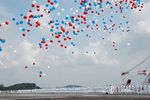
Sailors man the rails of the aircraft carrier USS Kitty Hawk (CV 63) as balloons are released from the flight deck. Kitty Hawk is returning to the United States for decommissioning after 10 years of service in Fleet Activities Yokosuka.YOKOSUKA, Japan (May 28, 2008) Sailors man the rails of the aircraft carrier USS Kitty Hawk (CV 63) as balloons are released from the flight deck. Kitty Hawk is returning to the United States for decommissioning after 10 years of service in Fleet Activities Yokosuka and will soon be relieved by the Nimitz-class nuclear-powered aircraft carrier USS George Washington (CVN 73). U.S. Navy photo by Mass Communication Specialist Seaman Brendan Morgan (Released)Sep 28, 2008
|
|
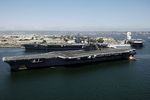
SAN DIEGO (Aug. 7, 2008) The aircraft carrier USS Kitty Hawk (CV 63) moves past the nuclear-powered aircraft carrier USS George Washington (CVN 73), in background, as Kitty Hawk prepares to moor at Naval Air Station North Island, San Diego.SAN DIEGO (Aug. 7, 2008) The aircraft carrier USS Kitty Hawk (CV 63) moves past the nuclear-powered aircraft carrier USS George Washington (CVN 73), in background, as Kitty Hawk prepares to moor at Naval Air Station North Island upon her return to San Diego Thursday, Aug. 7, 2008. Kitty Hawk will be decommissioned next year in Bremerton, Wash. The 46- year-old carrier is the oldest active-duty warship in the Navy and will be replaced this summer George Washington as the Navy's only permanently forward-deployed aircraft carrier. (U.S. Navy photo by Mass Communication Specialist 3rd Class Kyle D. Gahlau/Released)Sep 28, 2008
|
|
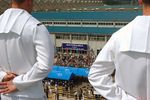
Sailors watch the pier while manning the rails aboard the aircraft carrier USS Kitty Hawk (CV 63) during the ship's final departure from Fleet Activities Yokosuka.YOKOSUKA, Japan (May 28, 2008) Sailors watch the pier while manning the rails aboard the aircraft carrier USS Kitty Hawk (CV 63) during the ship's final departure from Fleet Activities Yokosuka. Kitty Hawk is returning to the United States for decommissioning after 10 years of service in Fleet Activities Yokosuka and will soon be relieved by the Nimitz-class nuclear-powered aircraft carrier USS George Washington (CVN 73). U.S. Navy photo by Mass Communication Specialist Seaman Brendan Morgan (Released)Sep 28, 2008
|
|

Kitty Hawk, the Navy's oldest active warship and only forward-deployed aircraft carrier, will soon be relieved by the Nimitz-class nuclear-powered aircraft carrier USS George Washington (CVN 73).YOKOSUKA, Japan (May 28, 2008) Sailors man the rails of the aircraft carrier USS Kitty Hawk (CV 63) as the ship departs Fleet Activities Yokosuka for the last time. Kitty Hawk, the Navy's oldest active warship and only forward-deployed aircraft carrier, will soon be relieved by the Nimitz-class nuclear-powered aircraft carrier USS George Washington (CVN 73). U.S. Navy photo by Mass Communication Specialist 3rd Class Matthew R. White (Released)Sep 28, 2008
|
|
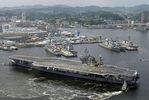
The aircraft carrier USS Kitty Hawk (CV 63) departs Yokosuka, Japan for the final time. Kitty Hawk, the oldest carrier in the U.S. Navy and the only conventional-powered aircraft carrier, will be replaced this summer by the nuclear-powered GW.YOKOSUKA, Japan (May 28, 2008) The aircraft carrier USS Kitty Hawk (CV 63) departs Yokosuka, Japan for the final time. Kitty Hawk, the oldest carrier in the U.S. Navy and the only conventional-powered aircraft carrier, will be replaced this summer by the nuclear-powered aircraft carrier USS George Washington (CVN 73). U.S. Navy photo by Mass Communication Specialist 3rd Class Kyle D. Gahlau (Released)Sep 28, 2008
|
|
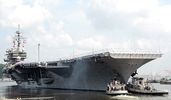
The aircraft carrier USS Kitty Hawk departs its forward-deployed operating base of Yokosuka, Japan for the last time. Kitty Hawk is the oldest active warship and the only conventional-powered aircraft carrier in the Navy. YOKOSUKA, Japan (May 28, 2008) The aircraft carrier USS Kitty Hawk departs its forward-deployed operating base of Yokosuka, Japan for the last time. Kitty Hawk is the oldest active warship and the only conventional-powered aircraft carrier in the Navy. Kitty Hawk will be replaced by the nuclear-powered aircraft carrier USS George Washington (CVN 73). U.S. Navy photo by Mass Communication Specialist 2nd Class Shawn Cole (Released)Sep 28, 2008
|
|
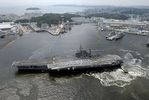
YOKOSUKA, Japan (May 28, 2008) Sailors spell out "Sayonara" on the flight deck of the aircraft carrier USS Kitty Hawk (CV 63) as the ship departs Yokosuka, Japan for the final time.YOKOSUKA, Japan (May 28, 2008) Sailors spell out "Sayonara" on the flight deck of the aircraft carrier USS Kitty Hawk (CV 63) as the ship departs Yokosuka, Japan for the final time. Sayonara is Japanese for "goodbye." Kitty Hawk will be replaced by the nuclear-powered aircraft carier USS George Washington (CVN 73). U.S. Navy photo by Mass Communication Specialist 3rd Class Kyle D. Gahlau (ReleasedSep 28, 2008
|
|
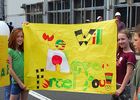
Students from Yokosuka Middle School hold up a sign honoring the aircraft carrier USS Kitty Hawk (CV 63) as the ship prepares to depart Fleet Activities Yokosuka for the last time.YOKOSUKA, Japan (May 28, 2008) Students from Yokosuka Middle School hold up a sign honoring the aircraft carrier USS Kitty Hawk (CV 63) as the ship prepares to depart Fleet Activities Yokosuka for the last time. Kitty Hawk, the Navy's oldest active warship and only forward-deployed aircraft carrier, will soon be relieved by the Nimitz-class nuclear-powered aircraft carrier USS George Washington (CVN 73). U.S. Navy photo by Mass Communication Specialist 3rd Class Matthew R. White (Released)Sep 28, 2008
|
|
| 3524 files on 14 page(s) |
 |
 |
11 |  |
 |
|